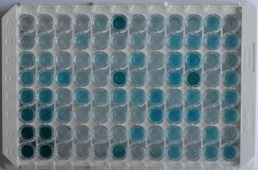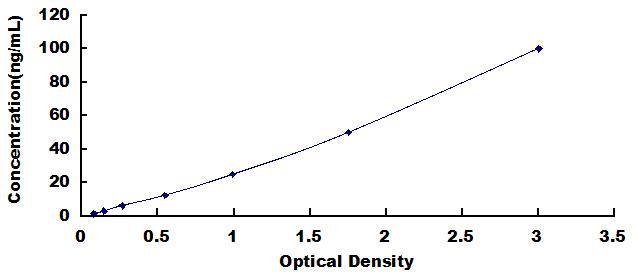Packages (Simulation)

Reagent Preparation

Image (I)
Image (II)
Certificate


ELISA Kit for Anti-Actin Antibody (Anti-ACTIN)
- Product No.AES097Hu
- Organism SpeciesHomo sapiens (Human) Same name, Different species.
- Sample Typeserum, plasma and other biological fluids
- Test MethodIndirect ELISA
- Assay Length2h, 30min
- Detection Range1.56-100ng/mL
- SensitivityThe minimum detectable dose of this kit is typically less than 0.63ng/mL.
- DownloadInstruction Manual
- UOM 48T96T 96T*5 96T*10 96T*100
- FOB
US$ 630
US$ 900
US$ 4050
US$ 7650
US$ 63000
For more details, please contact local distributors!
Specificity
This assay has high sensitivity and excellent specificity for detection of Anti-Actin Antibody (Anti-ACTIN).
No significant cross-reactivity or interference between Anti-Actin Antibody (Anti-ACTIN) and analogues was observed.
Recovery
Matrices listed below were spiked with certain level of Anti-Actin Antibody (Anti-ACTIN) and the recovery rates were calculated by comparing the measured value to the expected amount of Anti-Actin Antibody (Anti-ACTIN) in samples.
| Matrix | Recovery range (%) | Average(%) |
| serum(n=5) | 82-92 | 85 |
| EDTA plasma(n=5) | 95-105 | 98 |
| heparin plasma(n=5) | 79-99 | 95 |
Precision
Intra-assay Precision (Precision within an assay): 3 samples with low, middle and high level Anti-Actin Antibody (Anti-ACTIN) were tested 20 times on one plate, respectively.
Inter-assay Precision (Precision between assays): 3 samples with low, middle and high level Anti-Actin Antibody (Anti-ACTIN) were tested on 3 different plates, 8 replicates in each plate.
CV(%) = SD/meanX100
Intra-Assay: CV<10%
Inter-Assay: CV<12%
Linearity
The linearity of the kit was assayed by testing samples spiked with appropriate concentration of Anti-Actin Antibody (Anti-ACTIN) and their serial dilutions. The results were demonstrated by the percentage of calculated concentration to the expected.
| Sample | 1:2 | 1:4 | 1:8 | 1:16 |
| serum(n=5) | 80-99% | 86-93% | 83-91% | 88-102% |
| EDTA plasma(n=5) | 80-93% | 92-102% | 93-101% | 82-91% |
| heparin plasma(n=5) | 92-102% | 80-103% | 93-101% | 96-103% |
Stability
The stability of kit is determined by the loss rate of activity. The loss rate of this kit is less than 5% within the expiration date under appropriate storage condition.
To minimize extra influence on the performance, operation procedures and lab conditions, especially room temperature, air humidity, incubator temperature should be strictly controlled. It is also strongly suggested that the whole assay is performed by the same operator from the beginning to the end.
Reagents and materials provided
| Reagents | Quantity | Reagents | Quantity |
| Pre-coated, ready to use 96-well strip plate | 1 | Plate sealer for 96 wells | 4 |
| Standard | 2 | Standard Diluent | 1×20mL |
| Detection Reagent A | 1×120µL | Assay Diluent A | 1×12mL |
| TMB Substrate | 1×9mL | Stop Solution | 1×6mL |
| Wash Buffer (30 × concentrate) | 1×20mL | Instruction manual | 1 |
Assay procedure summary
1. Prepare all reagents, samples and standards;
2. Add 100µL standard or sample to each well. Incubate 1 hours at 37°C;
3. Aspirate and add 100µL prepared Detection Reagent A. Incubate 1 hour at 37°C;
4. Aspirate and wash 5 times;
5. Add 90µL Substrate Solution. Incubate 10-20 minutes at 37°C;
6. Add 50µL Stop Solution. Read at 450nm immediately.
GIVEAWAYS
INCREMENT SERVICES
| Magazine | Citations |
| Molecular and Cellular Biochemistry | Influence of signaling kinases on functional dynamics of nuclear receptor CAR Pubmed: 31352609 |
| BMC Neurosci | Association of decreased triadin expression level with apoptosis of dopaminergic cells in Parkinson's disease mouse model 34736417 |
| Life Sci | Indole-linked 1, 2, 3-triazole derivatives efficiently modulate COX-2 protein levels in human THP-1 monocytes by suppressing AGE-ROS-NF-kβ nexus Pubmed:34990649 |
| Cell Signal | Suppression of COX-2/PGE2 levels by carbazole-linked triazoles via modulating methylglyoxal-AGEs and glucose-AGEs–Induced ROS/NF-κB signaling in monocytes Pubmed:35640822 |
| Free Radical Biology and Medicine | Flavonoid 4, 4′-dimethoxychalcone induced ferroptosis in cancer cells by synergistically activating Keap1/Nrf2/HMOX1 pathway and inhibiting FECH Pubmed:35697292 |
| Catalog No. | Related products for research use of Homo sapiens (Human) Organism species | Applications (RESEARCH USE ONLY!) |
| PAS097Hu01 | Polyclonal Antibody to Actin (ACTIN) | WB; IHC; ICC; IP. |
| MAS097Hu21 | Monoclonal Antibody to Actin (ACTIN) | WB; IHC; ICC; IP. |
| AES097Hu | ELISA Kit for Anti-Actin Antibody (Anti-ACTIN) | Enzyme-linked immunosorbent assay for Antibody Detection. |








